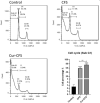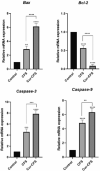Anticancer properties of curcumin-treated Lactobacillus plantarum against the HT-29 colorectal adenocarcinoma cells
- PMID: 36801895
- PMCID: PMC9938284
- DOI: 10.1038/s41598-023-29462-7
Anticancer properties of curcumin-treated Lactobacillus plantarum against the HT-29 colorectal adenocarcinoma cells
Abstract
Probiotic bacteria with functions of importance to the health and well-being of the host exhibit various medicinal properties including anti-proliferative properties against cancer cells. There are observations demonstrating probiotic bacteria and their metabolomics can be different in various populations with different eating habits. Here, Lactobacillus plantarum was treated with curcumin (the major compound of turmeric), and its resistance to the curcumin was determined. After then the cell-free supernatants of untreated bacteria (CFS) and bacteria treated with curcumin (cur-CFS) were isolated and their anti-proliferative properties against HT-29 colon cancer cells were compared. The ability of L. plantarum treated with curcumin to combat a variety of pathogenic bacterial species and its ability to survive in acidic conditions were evidence that the probiotic properties of the bacterium were unaffected by the curcumin treatment. L. plantarum treated with curcumin and intact L. plantarum were both able to live in acidic conditions, according to the results of the resistance to low pH test. The MTT result showed that CFS and cur-CFS dose-dependently decreased the growth of HT29 cells with a half-maximal inhibitory concentration of 181.7 and 116.3 µL/mL at 48 h, respectively. Morphological alteration of DAPI-stained cells also exhibited significant fragmentation in the chromatin within the nucleus of cur-CFS-treated cells compared to CFS-treated HT29 cells. Moreover, flow cytometry analyses of apoptosis and cell cycle confirmed DAPI staining and MTT assay results and stipulated the increased occurrence of programmed cell death (apoptosis) in cur-CFS-treated cells (~ 57.65%) compared to CFS-treated cells (~ 47%). These results were more confirmed with qPCR and exhibited the upregulation of Caspase 9-3 and BAX genes, and downregulation of the BCL-2 gene in cur-CFS- and CFS-treated cells. In conclusion, turmeric spice and curcumin may affect the metabolomics of probiotics in intestinal flora which could subsequently influence their anticancer properties.
© 2023. The Author(s).
Conflict of interest statement
The authors declare no competing interests.
Figures







Similar articles
-
In vitro effects of crocin on the possible anticancer properties of Lactococcus lactis against colorectal adenocarcinoma cells.Naunyn Schmiedebergs Arch Pharmacol. 2025 May;398(5):5729-5741. doi: 10.1007/s00210-024-03636-0. Epub 2024 Nov 28. Naunyn Schmiedebergs Arch Pharmacol. 2025. PMID: 39607550
-
Heat-killed probiotic bacteria induce apoptosis of HT-29 human colon adenocarcinoma cell line via the regulation of Bax/Bcl2 and caspases pathway.Hum Exp Toxicol. 2019 Sep;38(9):1069-1081. doi: 10.1177/0960327119851255. Epub 2019 May 22. Hum Exp Toxicol. 2019. PMID: 31117840
-
Cytotoxicity and Apoptosis Effects of Curcumin Analogue (2E,6E)-2,6-Bis(2,3-Dimethoxybenzylidine) Cyclohexanone (DMCH) on Human Colon Cancer Cells HT29 and SW620 In Vitro.Molecules. 2021 Feb 26;26(5):1261. doi: 10.3390/molecules26051261. Molecules. 2021. PMID: 33652694 Free PMC article.
-
Tumor-targeted induction of intrinsic apoptosis in colon cancer cells by Lactobacillus plantarum and Lactobacillus rhamnosus strains.Mol Biol Rep. 2023 Jun;50(6):5345-5354. doi: 10.1007/s11033-023-08445-x. Epub 2023 May 8. Mol Biol Rep. 2023. PMID: 37155013
-
What remains from living cells in bacterial lysate-based cell-free systems.Comput Struct Biotechnol J. 2023 May 24;21:3173-3182. doi: 10.1016/j.csbj.2023.05.025. eCollection 2023. Comput Struct Biotechnol J. 2023. PMID: 37333859 Free PMC article. Review.
Cited by
-
In vitro effects of crocin on the possible anticancer properties of Lactococcus lactis against colorectal adenocarcinoma cells.Naunyn Schmiedebergs Arch Pharmacol. 2025 May;398(5):5729-5741. doi: 10.1007/s00210-024-03636-0. Epub 2024 Nov 28. Naunyn Schmiedebergs Arch Pharmacol. 2025. PMID: 39607550
-
Exploring Anticancer Potential of Lactobacillus Strains: Insights into Cytotoxicity and Apoptotic Mechanisms on HCT 115 Cancer Cells.Biologics. 2024 Oct 1;18:285-295. doi: 10.2147/BTT.S477602. eCollection 2024. Biologics. 2024. PMID: 39372887 Free PMC article.
-
Probiotics and the Role of Dietary Substrates in Maintaining the Gut Health: Use of Live Microbes and Their Products for Anticancer Effects against Colorectal Cancer.J Microbiol Biotechnol. 2024 Oct 28;34(10):1933-1946. doi: 10.4014/jmb.2403.03056. Epub 2024 Aug 8. J Microbiol Biotechnol. 2024. PMID: 39210613 Free PMC article. Review.
-
Harmony unveiled: Intricate the interplay of dietary factor, gut microbiota, and colorectal cancer-A narrative review.SAGE Open Med. 2024 Aug 31;12:20503121241274724. doi: 10.1177/20503121241274724. eCollection 2024. SAGE Open Med. 2024. PMID: 39224896 Free PMC article. Review.
-
Porous Microgels for Delivery of Curcumin: Microfluidics-Based Fabrication and Cytotoxicity Evaluation.Micromachines (Basel). 2023 Oct 22;14(10):1969. doi: 10.3390/mi14101969. Micromachines (Basel). 2023. PMID: 37893406 Free PMC article.
References
-
- Carpenter S. That gut feeling. Monit. Psychol. 2012;43:50.
-
- Salmanzadeh R, et al. Propyl gallate (PG) and tert-butylhydroquinone (TBHQ) may alter the potential anti-cancer behavior of probiotics. Food Biosci. 2018;24:37–45. doi: 10.1016/j.fbio.2018.05.005. - DOI
Publication types
MeSH terms
Substances
LinkOut - more resources
Full Text Sources
Research Materials

